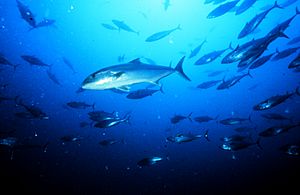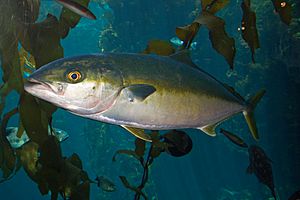Amberjack facts for kids
Quick facts for kids Amberjack |
|
|---|---|
 |
|
| Greater amberjack, Seriola dumerili off the coast of North Carolina | |
| Scientific classification | |
| Kingdom: | |
| Phylum: | |
| Class: | |
| Order: | |
| Family: |
Carangidae
|
| Genus: |
Seriola
|
Amberjacks are a type of fish found in the warm waters of both the Atlantic Ocean and Pacific Ocean. They belong to the Seriola genus, which is part of the Carangidae family. Many people enjoy fishing for amberjacks, making them a popular game fish.
There are several different kinds of amberjacks. Some common types include the greater amberjack, lesser amberjack, Almaco jack, yellowtail, and the banded rudderfish. Each type has its own special features and places where it likes to live.
Contents
Types of Amberjacks
Greater Amberjacks
The greater amberjack, known scientifically as Seriola dumerili, is the biggest type of jack fish. They often have dark stripes that run from their nose to the front of their dorsal fin. Unlike some other fish, they do not have scutes, which are bony plates on their bodies.
These fish usually weigh 18 kilograms (40 pounds) or less. You can often find them near rocky reefs, shipwrecks, or other underwater debris. They typically live in waters that are 20 to 75 meters (10 to 40 fathoms) deep. Greater amberjacks are found in both the Atlantic and Pacific Oceans.
Lesser Amberjacks
Lesser amberjacks, or Seriola fasciata, have bigger eyes and deeper bodies compared to greater amberjacks. Their bodies are usually olive green or brownish-black with shiny silver sides. They often have a dark band that goes upwards from their eyes.
Younger lesser amberjacks have wavy or split bars on their sides. Adult lesser amberjacks are usually smaller, weighing less than 5 kilograms (10 pounds). They prefer deeper waters than other jacks, often living 50 to 130 meters (30 to 70 fathoms) deep.
Amberjacks are very hungry hunters. They eat squid, other fish, and crustaceans like crabs and shrimp. Scientists believe they lay their eggs in the open ocean for most of the year. Young amberjacks can be found in shallower waters, around 25 feet (7.6 meters) deep, often near floating objects.
Banded Rudderfish
The banded rudderfish, Seriola zonata, is the second-smallest type of amberjack. You can tell it apart from a pilot fish because it has a first dorsal fin. Young banded rudderfish have vertical stripes, much like pilotfish, and often swim alongside large objects or animals.
Older banded rudderfish (over 10 inches long) lose their stripes. These fish are often caught but not always correctly identified. Large ones, with a "raccoon-stripe" over their eye and a golden stripe on their side, are sometimes mistaken for other amberjacks. Young ones are often called pilotfish.
Banded rudderfish can be found as far north as Nova Scotia. They are not as dependent on following sharks or other large animals as pilotfish are. You can catch them using shrimp, small fish called silversides, or fishing lures like spoons and flies.
Other Amberjack Species
There are other types of amberjacks found in different parts of the world. These include the yellowtail amberjack (which has types like the Asian yellowtail, California yellowtail, and yellowtail kingfish), the Almaco jack, and the Japanese amberjack (also known as the five-ray yellowtail).
Amberjack Biology
Amberjacks are active predators, meaning they hunt other animals for food. They eat fish that live in the open ocean (called pelagic fish) and fish that live near the ocean floor (called benthic fish). Their diet also includes squid, crustaceans, sardines, and bigeye scad. Younger amberjacks mostly eat tiny sea creatures like plankton and small invertebrates.
Greater amberjacks become adults and can reproduce when they are about four years old. They migrate to deeper waters to lay their eggs from late spring to early summer (March to June). They often choose places near shipwrecks or other large underwater objects to keep their young safe.
Female amberjacks are usually much larger than males. They also live longer. The longest a female amberjack has been known to live is 17 years. However, on average, they live about 10 years. This is partly because they are popular for big game fishing and are also a tasty food fish.
Amberjacks are not at the very top of the food chain in their ocean homes. They can be hunted by larger fish like Yellowfin tuna, sharks, and other big predators.
Names and Culture
- Two United States Navy submarines have been named USS Amberjack.
- An offshore oil platform in the Gulf of Mexico is named "Amberjack". It is located south of the Louisiana shore.
- The band Béla Fleck and the Flecktones has a song called "Amberjack".
- A minor league baseball team in Monterey, California, is called the Amberjacks. They play in the independent Pecos League.



